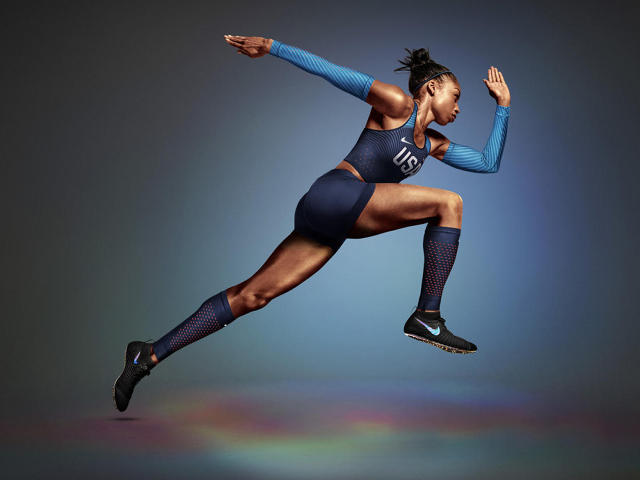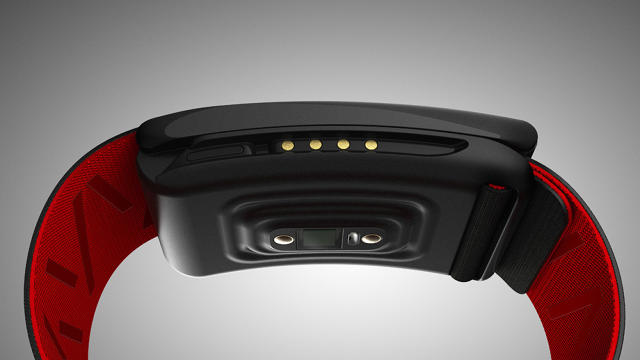Keep your eyes peeled for these innovative items.
As of writing, the United States has won 84 medals at the 2016 Summer Olympics in Rio, almost twice as many as any other country competing this year, and the most gold medals Team USA has ever won at a single Olympic Games. Most of the credit for this incredible record undeniably goes to the athletes. But America also has a technological and design edge when it comes to the Games: Our athletes tend to have the best and most innovative gear first.
You might miss some of these details while you're watching from the couch, so here's what to look for during the remaining days of competition, which wraps up next weekend.
Nike AeroSwift and AeroBlades

Usually, athletes try to get faster by getting sleeker, wearing tight-fitting uniforms or shaving their hair to cut down on wind resistance. As part of Rio 2016, though, Nike's taking the opposite approach. The company created AeroBlades: little patches made up of tiny hooks or spikes that runners can wear either as leg or arm sleeves, or as a Nicoderm-like patch they can stick to their skin. The AeroBlades subtly influence the way air moves over an athlete's body to essentially give them their own natural jet streams, pretty much the same way fins on a fast car or airplane work. It's an effective bit of gear that has helped some of the runners on America's track and field team win 11 medals so far, including four-time Olympic champion Allyson Felix.
Hykso Punching Sensors

Data tracking is a big part of not just Olympic competition, but Olympic training. In the field of boxing, the newest wearable is the Hykso: a Y Combinator-funded sensor developed specifically for boxers. The Hykso—used by the U.S. and Canadian boxing teams—can tell what kind of punch a fighter is throwing, as well as measure their intensity and velocity. In sparring sessions, fighters are able to go to town on each other—then look at the statistical data afterward to get a better sense of their own (and their opponents') weaknesses. So far, the Hykso punching sensor has helped the U.S. win the bronze in boxing. Amateur pugilists can preorder a pair here.
Speedo LZR Fastskin Suits

Ever since the international governing body banned"high-tech swimsuits" (that cover the entire body in non-permeable, highly compressive polyurethane) from the sport, Speedo has essentially had to make its LZR line of suits less effective than they were when they completely upended competitive swimming seven years ago. These advantages were seen as a form of "tech doping" by some commentators, and new rules dictate how much of a swimmer's body a swimsuit can cover and that it be made of permeable materials.
Nevertheless, Speedo continues to innovate with its LZR series, outfitting teams from not just the U.S., but Australia, China, Spain, Japan, Canada, and Israel, at Rio 2016 with two new suits: the Fastskin LZR Racer X and Fastskin LZR Racer 2. Both suits compress a swimmer's body to make them more hydrodynamic, resulting in faster speeds. This tech comes at the expense of convenience: Speedo says it can take a swimmer up to 10 minutes to get into one of the Fastskin suits. The Fastskins were designed based upon data from 330 elite swimmers, including Ryan Lochte, to make them more comfortable to wear. The theory goes that the more natural an athlete feels, the better their performance ought to be in the water. Sadly the swimming events are now over, but tech seems to have worked: American swimmers won 33 medals this year.
Nike Wing

In appearance, the Nike Wing sunglasses look like a hologram folded around the face; an early Lawnmower Man-era experiment in CGI, turned into a fashion statement. The Wing's single-piece, hingeless design, though, serves a purpose. It helps reduce drag for members of the U.S. Olympics track team, while also weighing four grams less than traditional eyewear. Useful for a runner in Rio's blinding sun, but if you're not a member of the U.S. track team, these shades will cost you a staggering $12,000 a pair.
Solos AR Cycling Glasses

A set of smart cycling glasses with a built-in HUD micro-display, the Solos AR Cycling Glasses have been used by the U.S. Cycling Team during training to let them know their speed, heart rate, power (in watts), and cadence (in rotations per minute), according to USA Today. The glasses can connect via Bluetooth to a cyclist's bike computer or their iPhone to provide further data analysis, and feature dual microphones and speakers so the cyclists can stay in touch with their coaches and be heard over the rush of the peloton. This is one of the few tech innovations on this list you can order for yourself, too.
Nike Zoom Superfly Shoes

Most of Nike's shoes at Rio 2016 aren't that different from the ones sold in stores, but there's one notable exception. Nike's premier shoe of the Rio 2016 Olympics is the Zoom Superfly. The upper part of the shoe is Flyweave, which is, of course, an old Nike staple—but that's not the interesting part. Rather, it's the spike plate on the bottom of the shoe that makes the Zoom Superflys innovative. Thanks to an algorithmically generated honeycomb pattern that maximizes strength while minimizing the amount of material needed, the spike plate on the bottom of these shoes is four times stiffer than normal, yet still weighs less than previous spike plates. The result? Sprinters get a better grip on the track as they run, without compromising on the weight of their shoe.
Whoop Strap

Remember Whoop, the wearable fitness tracker for elite athletes worn by LeBron James we wrote about earlier this year? U.S. swimmer Ryan Lochte (otherwise known as Pizzerina Sbarro's sex idiot from 30 Rock) is also boasting a Whoop at this year's Olympic Games. Unlike most fitness bands, which mostly track movement, the Whoop can measure everything from how much athletes have strained themselves during a session, to how they'll perform next day, thanks to advanced sensors that provide an EKG-like level of detail. The Whoop also allows athletes to measure their fitness more accurately than other wearables, because an innovative removable battery solution means it never needs to be taken off to recharge.